Facts About the Giants Gas Planets
- The gas giants are the four large planets that lie in the outer solar system, past the asteroid belt. These are Jupiter, Saturn, Uranus, and Neptune.
- The term “gas giants” was not coined by astronomers but by James Blish. The science-fiction writer called all giant planets “gas giants.” These planets are not completely gaseous though, as they most likely have a rocky core.
- In terms of composition, the four closest planets to the Sun have rocky parts. However, the bigger Jovian planets are just big balls of gas (mostly hydrogen and helium) with no solid surface!
- As a terrestrial planet, the Earth is much smaller than the gas giants. In comparison, Jupiter’s diameter is roughly 11 times that of the Earth. Saturn is also bigger by more than nine times while Uranus and Neptune measure around four times across.
- The four gas giants in our solar system rotate relatively faster than the Earth and other terrestrial planets.
- While a day on our planet lasts 24 hours, a day on Jupiter is only about 10 hours. It is nearly 11 hours on Saturn, and about 17 and 16 Earth hours on Uranus and Neptune respectively.
- Moons are abundant among gas giant planets. With 82 moons (so far), Saturn holds the record for the most number of natural satellites known. It is followed by the previous record-holder Jupiter which has 79. Uranus has 27 and Neptune has 14.
- Saturn is known as the “ringed planet.” However, the other three gas giants also have their own sets of magnificent rings.
- Just like the Earth, gas giants also have wind bands. They also experience storms that are nothing like what we have seen, often lasting for so many years!
What Are Gas Giants?
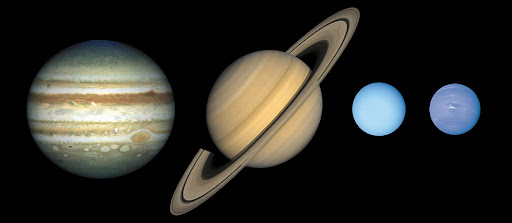
Gas giants are planets that are very different from our own. The words “gas giants” already tell us something about their size and composition. Unlike terrestrial planets whose composition is rocky, gas giants have a mostly gaseous composition, such as hydrogen and helium. They do have some rocky material, although this is most often found in the planet core.
Let’s take a look at our solar system. We can think of the asteroid belt as the dividing line between terrestrial and gas giant planets.
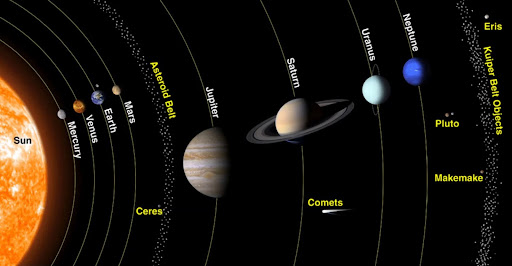
The first four planets from the Sun, Mercury, Venus, Earth, and Mars are terrestrial. The four gas giants (in order of distance from the Sun) are Jupiter, Saturn, Uranus, and Neptune. These planets are just big worlds of gas, so we can’t walk on them as we do here on Earth!
Other names we can call gas giants are giant planets or jovian planets. “Jovian” is from Jupiter, indicating that the other three planets are similar to it. Though they are still mostly called gas giants, it was discovered that Uranus and Neptune have different compositions.
Relative Distance of the Outer Planets From the Sun
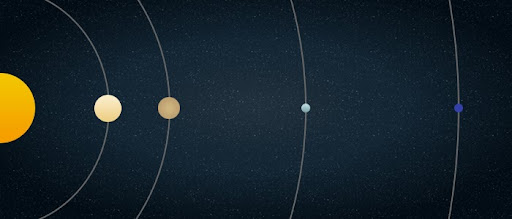
Composition
Planets are composed of different kinds of elements and compounds. To easily identify them, scientists grouped these planetary constituents into three:
- Rocks: silicates and metals
- Gases: hydrogen and helium
- Ices: water, methane, and ammonia
The terrestrial planets, including the Earth, are also called rocky planets because of the high presence of silicates and metals. Hydrogen and helium make up more than 90% of Jupiter and Saturn. They most likely have an outer layer of molecular hydrogen that surrounds a layer of liquid metallic hydrogen.
Uranus and Neptune are only about 20% hydrogen and helium. These two outer planets are mostly composed of “ices.” Because of this discovery in composition, Uranus and Neptune are more properly called ice giants.
Although ice giants have already been classified separately, Uranus and Neptune are still commonly called gas giants alongside Jupiter and Saturn. The cores of these gas giants are thought to be of rocky or metallic composition.
Did You Know?
Jupiter is sometimes called a “failed star.” That’s because it is made up of hydrogen and helium just like a star like our Sun. Still, it is not massive enough to generate energy and become a star.
Jupiter is the largest planet in our solar system but it is very small relative to the size of stars. It is not massive enough to kickstart the process of thermonuclear fusion in its core. In fact, Jupiter has to have at least 80 times its current mass to start this reaction and thus produce energy!
How and When Did Gas Giants Form?
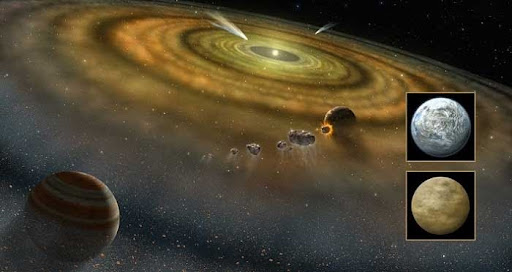
Gas giants have existed for billions of years and we have never seen the formation of one yet. Still, we can get an idea of how they started through theories and the use of computer simulations.
Everything started 4.6 billion years ago with the solar nebula. This cloud is composed of dust and gas that gave birth to the Sun. The rest of the nebula that was not used in its formation swirled around the Sun forming an accretion disk.
More and more dust grains accumulated on the disk, becoming larger balls of particles. These balls gently collided with each other and formed planetesimals. As they experienced more collisions, these kilometer-sized bodies became bigger protoplanets. These protoplanets orbited our Sun for about 10 to 100 million years.
Order From Chaos
Through gravity and more collisions, the eighth planets were formed. The gas giants started just like the solid terrestrial planets. However, the clouds of gas around a young star only stay for a few million years. Because of that, these solid planets that will later become the gas giants should quickly become larger to capture the gas while it still surrounds the Sun.
Most of the material in the nebula was pulled to form the Sun. The strong stellar wind blew away most of the gases of the nearer terrestrial planets. This steady stream from the Sun did not strip off the gases of the gas giants because they are much farther from it.
Still, the universe remains a big mystery, but these theories can help us understand how things may have started.
Extrasolar Gas Giants
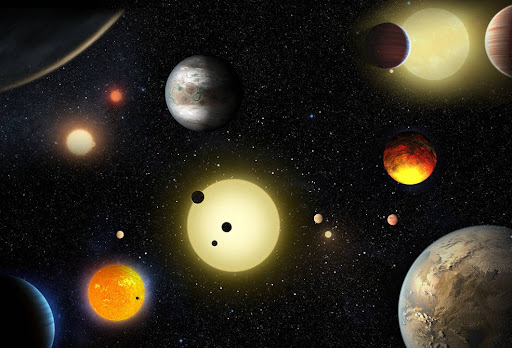
Extrasolar planets, or exoplanets for short, are planets outside the solar system. They come in all sizes and orbit a different star. Some of them are much bigger than Jupiter while some are about the size of the terrestrial planets.
Scientists categorize exoplanets based on the planets of our solar system. That way, we can get an idea of how they compare to the more familiar worlds that orbit the Sun. Still, that does not mean that these planets are similar. Each star system is unique and so are the planets around it.
Did You Know?
Some exoplanets are known to orbit two stars at once. They are called circumbinary planets. Rogue planets are also unique objects that are not bound in any planetary system. These sunless planets just wander aimlessly in space!
An exoplanet can be classified as a gas giant, Neptune-like, super-Earth, and terrestrial.
- Gas Giants (Gas planets) have sizes comparable to that of Jupiter and Saturn. Those that are more massive than Jupiter are called super-Jupiters. Some of these gas giants lie very close to the star, typically less than 0.1 AU. These scorching worlds are called hot Jupiters.
- Neptune-like or Neptunian planets are as big as Neptune and Uranus. They are believed to have similar hydrogen-helium atmospheres and rocky cores. Some of these exoplanets are called hot Neptunes (Hoptunes). They orbit very close to the host star, at less than 1 AU. In terms of size, planets that are smaller than Neptune but bigger than Earth are called mini-Neptunes.
- Super-Earths are terrestrial worlds that are at least twice as massive as our planet but lighter than Neptune. Some of these worlds may have atmospheres while others may not have.
- Terrestrial planets are also worlds made up of rock, water, silicate, or carbon. They are about the same size as the Earth or even smaller.
Types of Giant Gas Planets
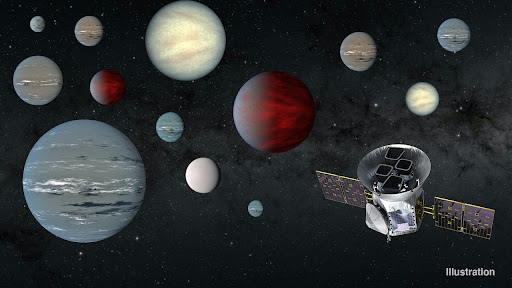
A newly published catalog reveals a fascinating variety of possible exoplanets detected by TESS, the Transiting Exoplanet Survey Satellite.
We already know that four gas giants orbit the Sun. Interestingly, there are way more of them outside the solar system. These extrasolar planets are very far so we do not have any idea what they look like.
A classification system was made to better understand these gas giants. It was proposed by David Sudarsky and colleagues in their study Albedo and Reflection Spectra of Extrasolar Giant Planets.
The five types of gas giants are classified based on their properties and appearance.
- Class I: Ammonia Clouds
Gas giants of this class are largely made up of ammonia clouds. They are believed to exist at temperatures less than about 150 K (−120 °C; −190 °F). These cold areas are typically in the outer regions of the planetary system where they belong. It could also mean that the star is very dim and cool.
Both Jupiter and Saturn belong are class I gas giants in this scheme. Possible class I exoplanets include 55 Cancri d, 47 Ursae Majoris c, and Upsilon Andromedae e.
- Class II: Water Clouds
Class II gas giants have temperatures around 250 K (−23 °C; −10 °F). Since these are warmer, the clouds are made up of water vapor instead of ammonia. These planets would have higher albedo since they are covered with water clouds.
Possible class II gas giants include Gliese 876 b, HD 45364 c, and Ursae Majoris b.
- Class III: Cloudless
Gas giants that belong to class III do not form clouds because they do not have the chemicals needed to form them. These planets are around 350 K (80 °C; 170 °F) and 800 K (530 °C; 980 °F). They are believed to be located in the inner regions of their planetary systems and would look similar to the blue-colored worlds of Uranus and Neptune.
Possible class III gas giants include Kepler-89e, Upsilon Andromedae c, and 55 Cancri c.
- Class IV: Alkali Metals
Class IV and V giants are considered “hot Jupiters.” Planets that are considered class IV have temperatures above 900 K (627 °C; 1160 °F). Instead of methane, carbon monoxide becomes the dominant carbon-carrying molecule in the atmosphere.
These planets are increasingly abundant with alkali metals (such as sodium and potassium) but are predicted to have very low albedos.
Possible class IV gas giants include HD 209458 b, TrES-2b, and 55 Cancri b.
- Class V: Silicate Clouds
Class V gas giants can be extremely hot, with temperatures above 1400 K (1100 °C; 2100 °F), or they can be cooler, with lower gravity than Jupiter. Planets with these temperatures are believed to have silicate and iron cloud decks in the atmosphere.
Possible class V gas giants include Upsilon Andromedae b, Kepler-7b, and HAT-P-11b.
Gas Planet Giants in Our Solar System
The gas giants are the farthest yet largest planetary members of our solar system. Let’s get to know the four of them.
Jupiter

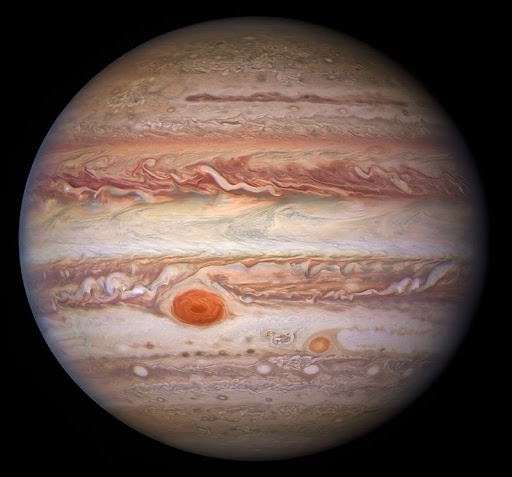
- Semi-Major Axis – 5.2044 AU
- Orbital Period – 11.9 Earth years
- Eccentricity – 0.0489
- Inclination – 1.303° (to the ecliptic)
- Mean Radius – 69,911 km (43,441 mi)
- Surface Area – 120.4 Earths
- Mass – 317.8 Earths
- Volume – 1,321 Earths
- Rotation Period – 9 h 55 m 33 s
- Average Temperature – -162°F (-108°C)
- Apparent Magnitude – -2.94 to -1.66
- Known Rings – 4
- Known Moons – 79
Jupiter is the 5th planet from the Sun. As the largest planetary member of the solar system, it has a fitting name. It was inspired by Roman mythology’s Jupiter whose Greek counterpart is Zeus, the king of the gods. Since it is a gas giant and is composed mostly of hydrogen, this planet does not have a solid surface.
After the Moon and the hottest planet, Venus, Jupiter is the third brightest object we can see in the night sky. It lies roughly 5.2 astronomical units (AU) from the Sun. If we combine all the other planets in the solar system, Jupiter would still be more than twice as massive!
A year on Jupiter is nearly 12 years longer than a year here on Earth, however, its rotation period is much shorter. This gas giant only takes 9 hours and 55 minutes to rotate, making it the fastest spinning planet in the solar system.
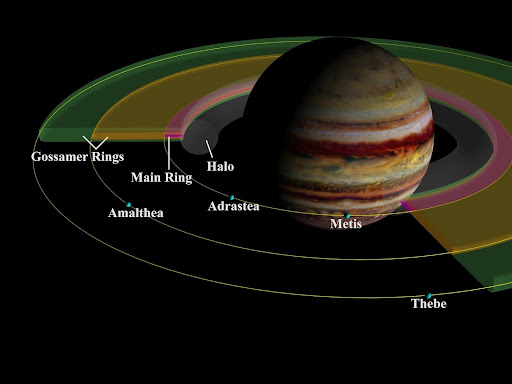
The planet Jupiter has four known rings made mostly of dust. This composition makes these rings hard to see since they do not reflect as much light. From closest to farthest, the four rings of Jupiter are the halo ring, the main ring, the Amalthea gossamer ring, and the Thebe gossamer ring.
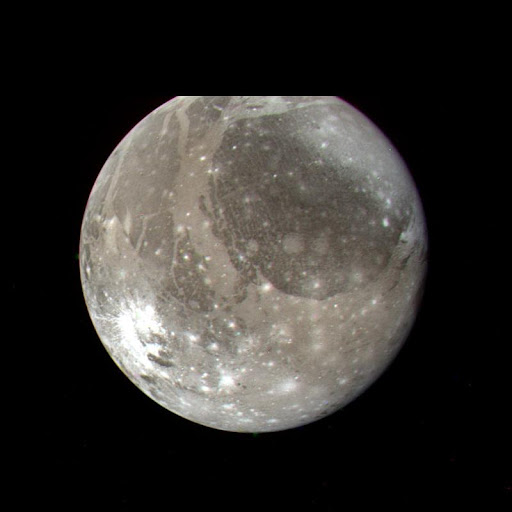
Jupiter has 79 known moons, 53 were already named while 26 still await naming. The largest of these Jovian moons are Io, Europa, Ganymede, and Callisto. These four are also called the Galilean moons.
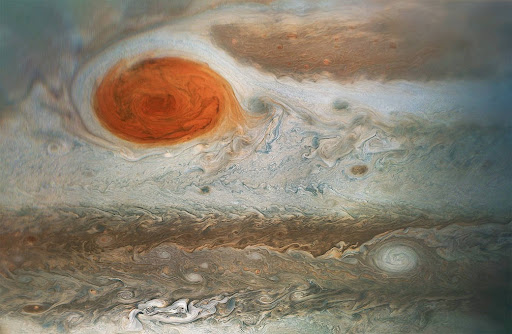
The Great Red Spot is a big storm in the southern part of Jupiter. It is much stronger than any storm we have experienced here on Earth. It is more than twice as large as our planet. Also, the storm of the Great Red Spot has been going on for so many years. It is believed to have existed even before 1665. [Learn more facts about Jupiter]
Saturn

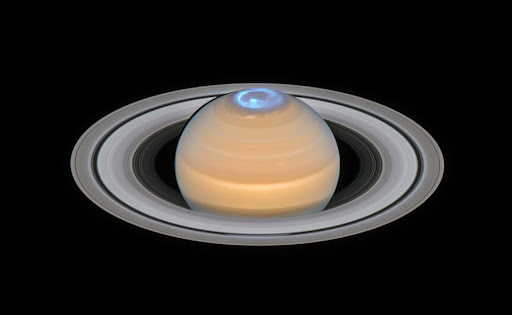
- Semi-Major Axis – 9.5826 AU
- Orbital Period – 29.4571 Earth years
- Eccentricity – 0.0565
- Inclination – 2.485° (to the ecliptic)
- Mean Radius – 58,232 km (36,184 mi)
- Surface Area – 83.703 Earths
- Mass – 95.159 Earths
- Volume – 763.59 Earths
- Rotation Period – 10h 32m 36s
- Average Temperature – -218°F (-138°C)
- Apparent Magnitude – −0.55 to +1.17
- Known Rings – 7 (main rings)
- Known Moons – 82
Saturn is the second-largest planet in the solar system after Jupiter. It is the sixth planet from the Sun. The name of this gas giant was from the ancient Roman god Saturn, the equivalent of the Greek god Cronus.
Planet Saturn is 9.5826 AU from the Sun. It is famously known as the ringed planet because of its bright and magnificent rings. These rings are mostly made up of ice and rock. From the planet, the seven major rings are Ring D, C, B, A, F, G, and E. Meanwhile, other rings are also being discovered like that of the outer moon, Phoebe. Some moons also have faint rings.
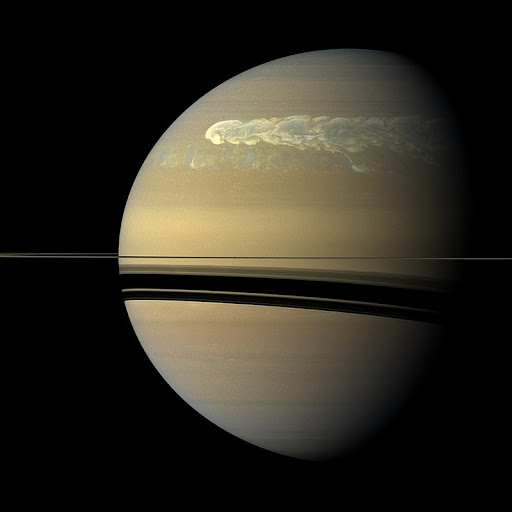
Just like other planets, Saturn also has storms. The area called the Great White Spot or the Great White Oval has been observed periodically. In Saturn’s southern hemisphere, there is also a giant thunderstorm called the Dragon Storm. Radio emissions are produced when the storm is on the night side and end when faced with sunlight.
Saturn has its own northern lights or aurora borealis just like the Earth. However, because most of the planet’s atmosphere is hydrogen, these light shows can only be seen in ultraviolet light.
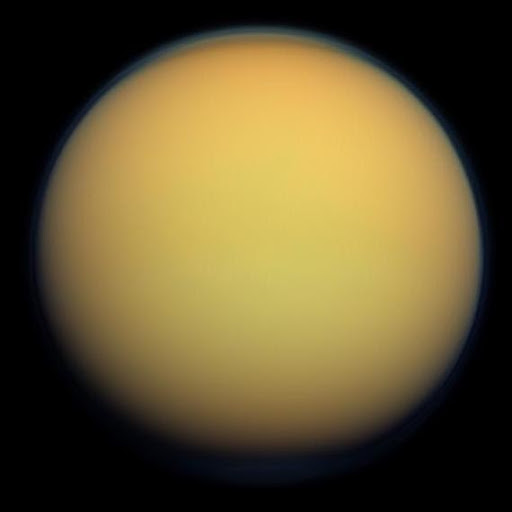
Saturn herds 82 moons, 53 of which were already named. It also has small natural satellites or moonlets in the rings. The largest Saturnian moon is Titan, which is also the second-largest in the solar system after the Jovian moon Ganymede.
Titan is a promising world as it is the only natural satellite that has a substantial atmosphere. It also has lakes and rivers just like the Earth. [Learn more facts about Saturn]
Uranus

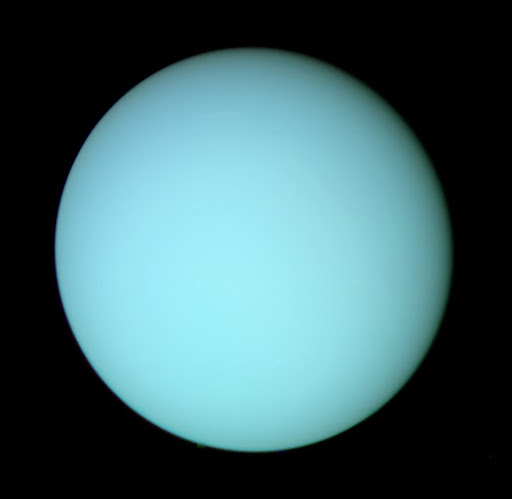
- Semi-Major Axis – 19.2185 AU
- Orbital Period – 84.0205 Earth years
- Eccentricity – 0.046381
- Inclination – 0.773° (to the ecliptic)
- Mean Radius – 25,362 km (15,759 mi)
- Surface Area – 15.91 Earths
- Mass – 14.536 Earths
- Volume – 63.086 Earths
- Rotation Period – 17h 14m 23s (retrograde)
- Average Temperature – -320°F (-195°C)
- Apparent Magnitude – 5.38 to 6.03
- Known Rings – 13
- Known Moons – 27
Uranus is a unique planet because it rotates on its side. Additionally, it rotates differently from the other planets. While the rest of the planets in the solar system move from west to east, Uranus and Venus move from east to west. This planet was named after the primal Greek god and personification of the sky.
With a semi-major axis of about 19 AU, Uranus is the seventh planet from our central star, the Sun. It has a long orbital period of 84 years but has a much shorter day period which is about 17 hours.
Uranus is a very cold and windy world. It is mostly made up of “ices” and other hydrocarbons. It has the third-largest diameter among the eight planets in the solar system.
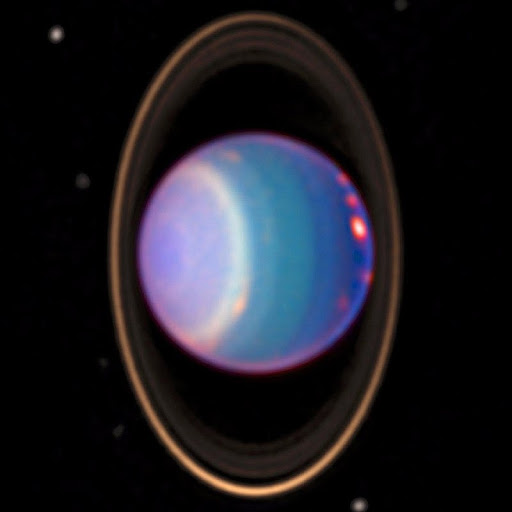
Like other gas giants, Uranus is also surrounded by rings. This sideways planet has 13 rings that are mostly opaque. They are designated using the Greek alphabet system.
Uranus has 27 confirmed moons. They are grouped into three. Five are major moons, 13 are inner moons, and 9 are irregular moons. They are named after characters from the literary works of authors William Shakespeare and Alexander Pope. The five major moons, which are ellipsoidal in shape, are Miranda, Ariel, Umbriel, Titania, and Oberon. [Learn more facts about Uranus]
Neptune

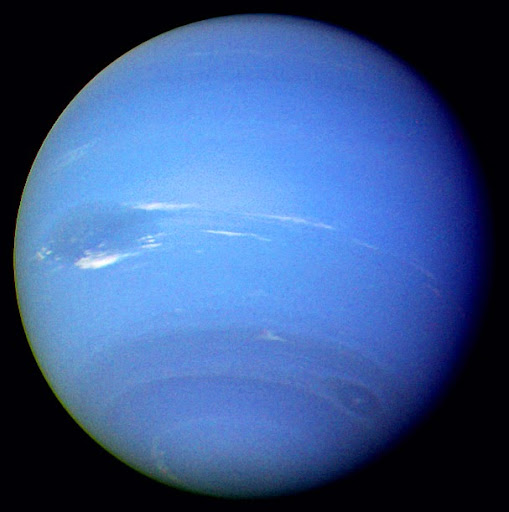
Semi-Major Axis – 30.07 AU
Orbital Period – 164.8 Earth years
Eccentricity – 0.008678
Inclination – 1.770° (to the ecliptic)
Mean Radius – 24,622 km (15,299 mi)
Surface Area – 14.98 Earths
Mass – 17.147 Earths
Volume – 57.74 Earths
Rotation Period – 16h 6m 36s
Average Temperature – -331°F (-201°C)
Apparent Magnitude – 7.67 to 8.00
Known Rings – 5
Known Moons – 14
Neptune is the eighth planet from the Sun. As the farthest planetary member in our own solar system, it is roughly 30 AU away. It was named after the god of the sea in Roman mythology, who is the Greek equivalent of Poseidon.
Neptune is the only planet that we cannot see with the naked eye. It had a different means of discovery, which was done through mathematical prediction instead of empirical observation.
The presence of methane accounts for the deep blue appearance of this planet, earning it the nickname “blue planet.” Neptune is the densest of all the giant planets. A Neptunian day is only about 16 hours long. However, it has a very long orbital period which takes roughly 165 years here on Earth.
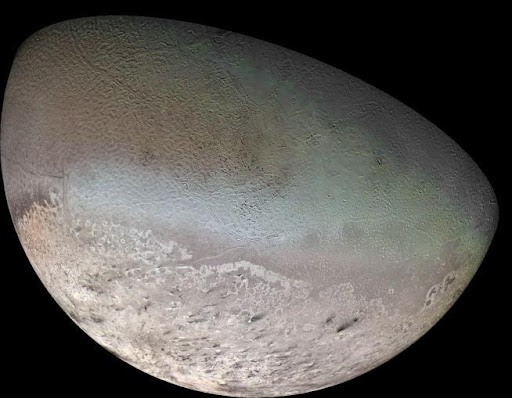
Fourteen moons have been discovered so far in the Neptunian system. They were named after minor water deities in Greek mythology. The largest natural satellite of Neptune, Triton, is the only large moon with a retrograde orbit.
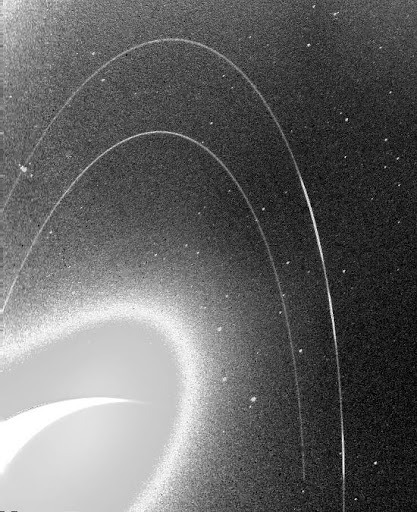
The blue planet has at least five rings: Galle, Leverrier, Lassell, Arago, and Adams. Some areas of the Adams ring are brighter than the others. These clumps of particles are called arcs. These arcs are called Liberté (Liberty), Egalité (Equality), Fraternité (Fraternity), and Courage. [Learn more facts about Neptune]
Sources
(https://earthsky.org/space/is-jupiter-a-failed-star/)
https://en.wikipedia.org/wiki/Ice_giant
https://en.wikipedia.org/wiki/Gas_giant#Cold_gas_giants
https://www.lpi.usra.edu/education/space_days/activities/gasGiants/aboutGasGiants.pdf
https://en.wikipedia.org/wiki/Sudarsky%27s_gas_giant_classification
https://solarsystem.nasa.gov/resources/681/solar-system-temperatures/
https://exoplanets.nasa.gov/what-is-an-exoplanet/planet-types
https://www.khanacademy.org/humanities/big-history-project/solar-system-and-earth/earth-and-form-solar-system/a/how-our-solar-system-formed
https://epl.carnegiescience.edu/news/steam-worlds-mystery-how-gas-giants-form
https://en.wikipedia.org/wiki/Jupiter
https://en.wikipedia.org/wiki/Saturn
https://en.wikipedia.org/wiki/Uranus
https://en.wikipedia.org/wiki/Neptune
Image Sources
Gas giants: https://upload.wikimedia.org/wikipedia/commons/thumb/4/46/Gas_planet_size_comparisons.jpg/1200px-Gas_planet_size_comparisons.jpg
Solar system: https://solarstory.net/img/articles/big/configuration-of-the-solar-system.jpg
Solar system formation: https://mobile.arc.nasa.gov/public/iexplore/missions/pages/yss/November-1.jpg
Exoplanets: https://www.nasa.gov/sites/default/files/styles/full_width/public/thumbnails/image/kepler_all-planets_may2016.jpg?itok=4ZCpII0D
Gas giants and the TESS space telescope: https://exoplanets.nasa.gov/system/news_items/main_images/1677_TOIs_1280.jpeg
Jupiter: https://upload.wikimedia.org/wikipedia/commons/thumb/8/84/Hubble_Visible_View_of_Jupiter.jpg/800px-Hubble_Visible_View_of_Jupiter.jpg
Jupiter astronomical symbol:
Jupiter rings: https://www.nasa.gov/centers/goddard/images/content/384929main_galileo_ringsbig_PIA01627_full.jpg
Saturn: https://upload.wikimedia.org/wikipedia/commons/thumb/3/3d/Saturn_and_its_northern_auroras_%28composite_image%29.tif/lossy-page1-1280px-Saturn_and_its_northern_auroras_%28composite_image%29.tif.jpg
Saturn astronomical symbol: https://upload.wikimedia.org/wikipedia/commons/thumb/7/74/Saturn_symbol.svg/800px-Saturn_symbol.svg.png
Titan moon: https://en.wikipedia.org/wiki/Titan_(moon)#/media/File:Titan_in_true_color.jpg
Uranus: https://upload.wikimedia.org/wikipedia/commons/d/db/Uranus_-_January_14_1986_%2831493183791%29.jpg
Uranus Astronomical symbol:
Uranus rings: https://upload.wikimedia.org/wikipedia/commons/thumb/e/e4/Uranusandrings.jpg/800px-Uranusandrings.jpg
Neptune: https://upload.wikimedia.org/wikipedia/commons/0/06/Neptune.jpg
Neptune astronomical symbol:
https://upload.wikimedia.org/wikipedia/commons/thumb/4/47/Neptune_symbol.svg/800px-Neptune_symbol.svg.png
Neptune rings: https://solarsystem.nasa.gov/internal_resources/4091
Triton moons: https://en.wikipedia.org/wiki/Triton_(moon)#/media/File:Triton_moon_mosaic_Voyager_2_(large).jpg